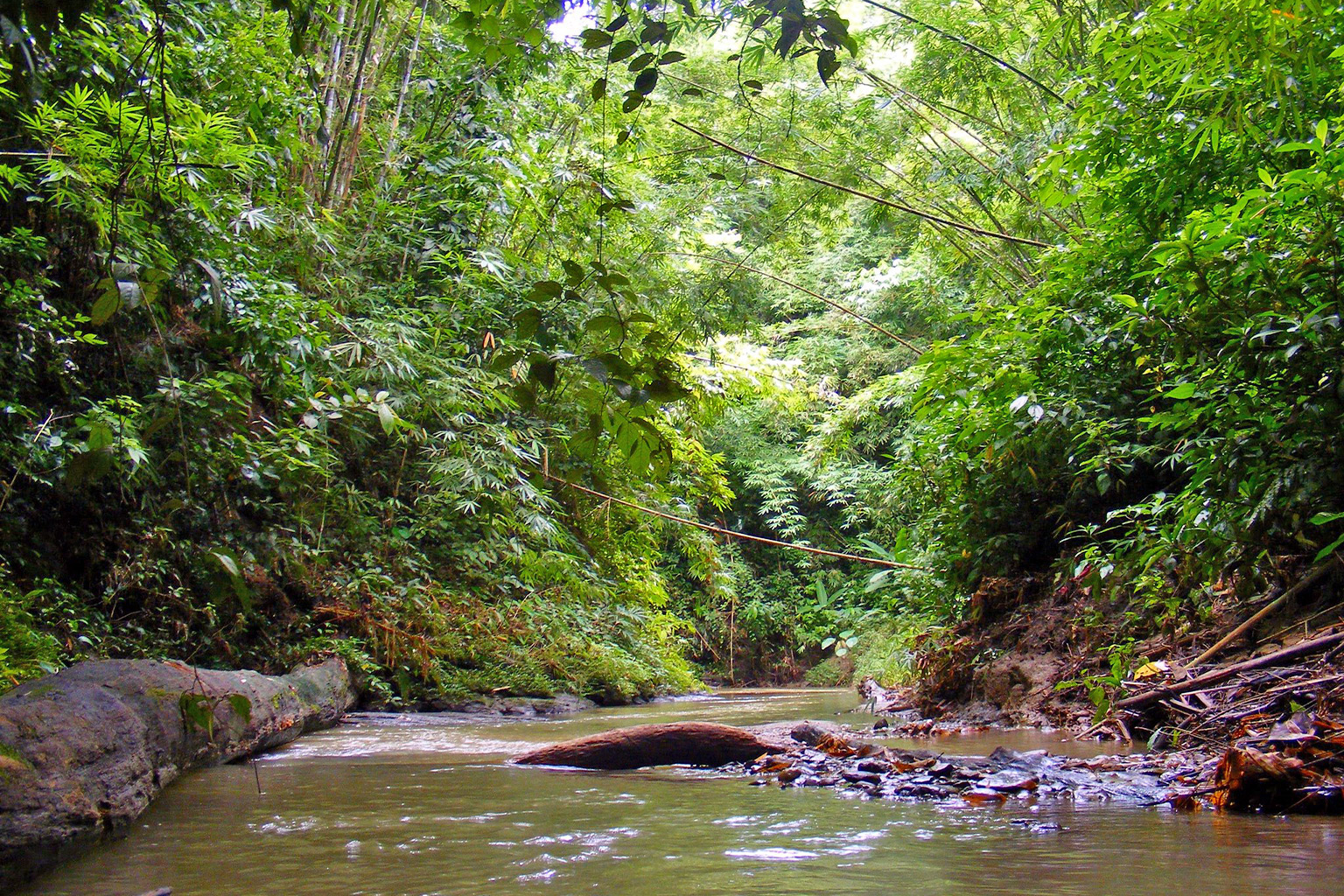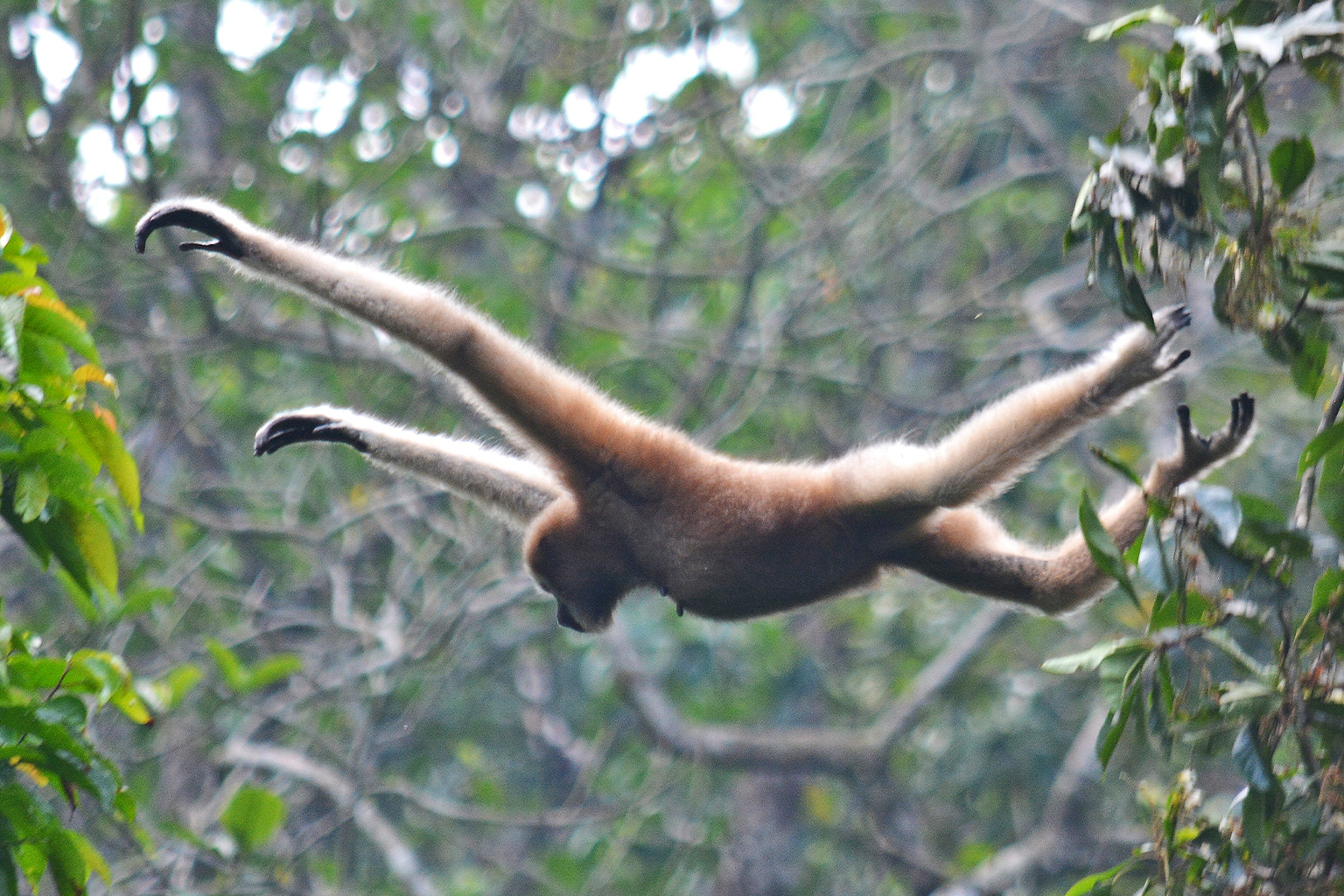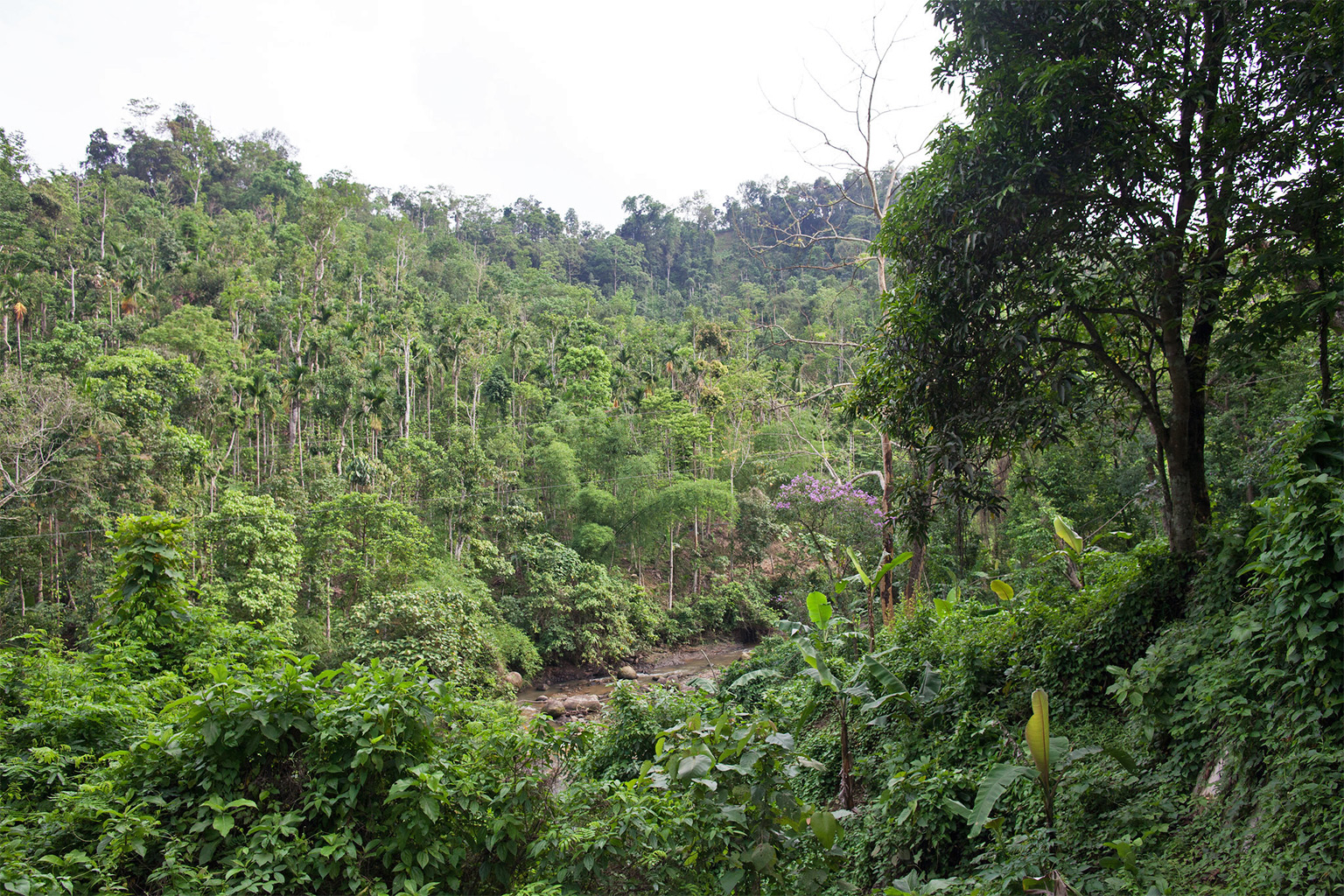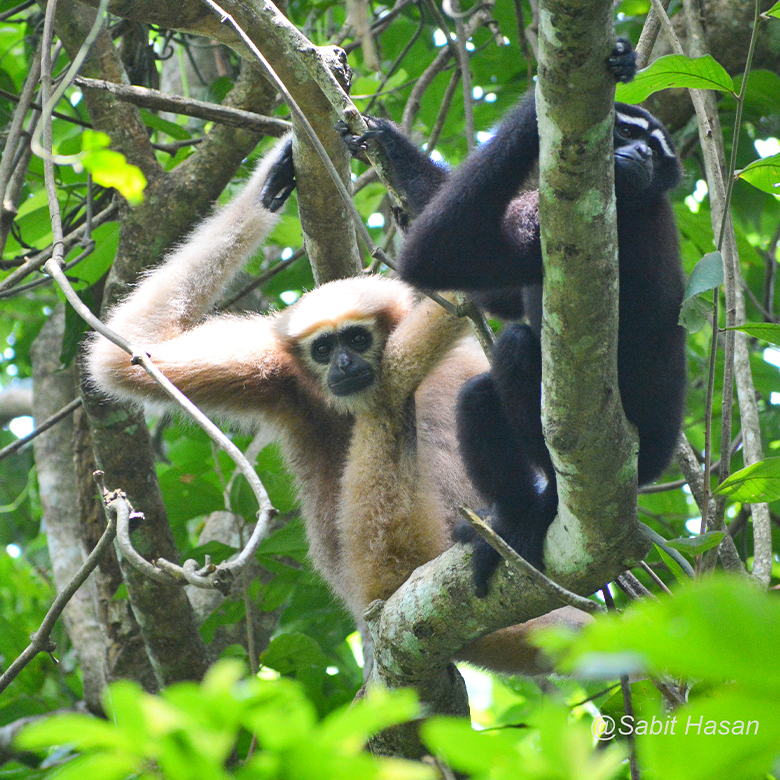- The western hoolock gibbon is a globally endangered species but in Bangladesh is considered critically endangered, due to continued habitat depletion, hunting and trafficking.
- According to a 2021 study, the country’s hoolock gibbon population dropped by around 84% over the past four decades, with the total estimated population now at just 469 individuals.
- Wildlife experts say the apes are hunted for food locally, and trafficked across the border to India and China for the illegal pet trade and for use in traditional medicine.
- They’ve called for an urgent conservation initiative to protect the gibbons and their habitats, including greater involvement by border guards and intelligence agents to crack down on trafficking.
DHAKA — On Oct. 8 this year, police in Bangladesh recovered an endangered western hoolock gibbon from a passenger bus in the Chunati area of the Chattogram-Cox’s Bazar highway. They also arrested two suspected wildlife traffickers, who were later convicted in court and sentenced to a year in prison and fined 10,000 taka ($97) each.
The hoolock gibbon (Hoolock hoolock) had been captured from the forests of the Chattogram Hill Tracts (CHT). And it wasn’t the first of its species rescued from the trafficking trade.
On Sept. 26 last year, police recovered a baby hoolock gibbon from another bus, this one on the Dhaka-Chattogram highway in Comilla.
Bangladesh’s Wildlife Conservation and Security Act 2012 prohibits the sale, purchase, import or export of wildlife. This includes western hoolock gibbons, an ape species that’s native to northeastern India, Bangladesh, and western Myanmar.
On the IUNC Red List, the species is categorized as endangered. The Bangladesh population of the gibbon, however, is considered critically endangered, confined to just a few viable habitats and highly vulnerable to the loss of that habitat and to poaching.
Ongoing human encroachment into the forests that the gibbons rely on has fragmented their populations, cutting them off from other groups. Small populations of less than 10 individuals are in particular danger of going locally extinct.
Drastic fall in hoolock gibbon population
Western hoolock gibbons play an important role in seed dispersal and forest regeneration. A 2021 study published in the journal Diversity showed the hoolock gibbon population has dropped by around 84% in Bangladesh in the past four decades.
From an estimated population of around 3,000 individuals in the 1980s, by 2020 there were only about 469 gibbons left in 135 groups in Bangladesh’s northeastern and southeastern forests, according to the study.
In the northeast, the Rajkandi Reserve Forest has the highest number, at around 122 gibbons, followed by the Patharia Reserve Forest (91), Lawachhara National Park (40), Satchhari National Park (nine), Rema-Kalenga Wildlife Sanctuary (five), and Sagarnal Forest, with just two gibbons.
In the southeast, the study found 86 gibbons in the Kaptai Forest, followed by the Sangu-Matamuhuri Reserve Forest (76), Innani Forest Reserve (18), Fasiakhali Wildlife Sanctuary (14), and Teknaf Wildlife Sanctuary (three). Some of the forests known to host hoolock gibbons in the past were found to have none this time around.
“Indiscriminate deforestation, food crisis and poaching are the main reasons behind the rapid decline in the hoolock population in Bangladesh,” said study co-author Sabit Hasan, a wildlife biologist at Jagannath University in Dhaka. “The ethnic people in Chattogram and the CHT hunt gibbons to eat its meat.”


Fragmented habitats
Hoolock gibbons spend most of their life in the trees, and fruits make up 65% of their diet, with 60% of the fruits being figs. The gibbons also eat lichens, invertebrates, bird eggs, plant parts including buds, shoots, leaves, and flowers. For an animal that has evolved to rely on a biodiverse ecosystem, the spread of crop monocultures or homogeneous forests spells doom.
“The hoolock gibbons are pure forest dwellers. They move from one place to another by hanging on trees,” said Monirul H. Khan, a zoology professor at Jahangirnagar University in Dhaka, who was not involved in the 2021 study.
The habitat of the western hoolock gibbon is strongly associated with contiguous canopy, broad-leaved, wet evergreen and semi-evergreen forests. But the species is threatened throughout its geographic range in Bangladesh, primarily by habitat destruction.
“Usually, the western hoolock gibbons do not get down from the trees,” Hasan said. “They travel from one tree to another by swinging from branch to branch high up in forest canopy. But their habitats — forests — are getting fragmented day by day due to deforestation. If the gibbons get isolated, they cannot survive.”
He cited the case of the Madhabkunda forest, once home to a large number of the apes but now completely bereft of them. He attributed their disappearance to the felling of the large trees they depended on, mostly by locals collecting betel leaves.
“If there is no connection among the trees, the gibbons will leave the forests,” Hasan added.

Rampant poaching and trafficking
Indigenous forest dwellers in the CHT region also hunt hoolock gibbons to eat, posing another threat to the species.
“Ethnic forest dwellers hunt wildlife, including gibbons, for food, while they hunt their babies to rear as pets, contributing to a rapid decline of the gibbon population,” Khan said.
The problem is compounded by wildlife traffickers, who capture the animals from the wild to sell them into the illegal pet trade, often internationally, using established trafficking routes.
During questioning by police, Jewel Rahman Sohel, the suspect arrested in connection with the baby gibbon seized from the bus on Sept. 26 last year, said he had planned to smuggle the animal across the border into India.
Khan said the western hoolock gibbon trade also flows east to China, via Myanmar and Thailand, driven by high demand for the primate.
Rezaul Karim Chowdhury, a divisional forest officer, said authorities recently recovered two baby gibbons whose mothers appeared to have been killed during the capture.
He added that information from the phone of a recently arrested trafficking suspect showed the individual planned to take a baby gibbon to India, further confirming the active presence of international wildlife traffickers in Bangladesh.

Urgent action needed
Experts say the isolated populations of hoolock gibbons in Bangladesh’s degraded and fragmented forests are highly vulnerable, and should be translocated to ensure their survival.
The 2021 study recommended carefully planned management, protection of habitats, management of people and their activities, and legislation and its enforcement to prevent the western hoolock gibbon going extinct in Bangladesh.
“The hoolock gibbons in Bangladesh are in a dire state as they have been living in different fragmented or degraded forests, in scattered ways. The natural forests and their habitats must be protected in a way to ensure their survival,” Khan said.
He called for forest corridors to be established to allow the gibbons to move from one patch of forest to another.
“Artificial canopy bridges could be set up in the fragmented habitats of the hoolock gibbons,” Hasan said.
Rezaul said that apart from forest officials, border guards and intelligence agents must strengthen their surveillance to crack down on wildlife poaching and trafficking in the country.
Banner image: The western hoolock gibbon is a globally endangered species but in Bangladesh is considered critically endangered. Image courtesy of Sabit Hasan.
Related reading:
Forest management tool could help rein in rampant wildlife trade in Bangladesh
Citations:
Naher, H., Al-Razi, H., Ahmed, T., Hasan, S., Jaradat, A., & Muzaffar, S. B., 2021. Estimated density, population size and distribution of the endangered western hoolock gibbon (Hoolock hoolock) in forest remnants in Bangladesh. Diversity, 12(10), 490. doi:10.3390/d13100490
Islam, M. A., Muzaffar, S. B., Feeroz, M. M., Kabir, M. M., Begum, S., Chowdhury, G. W., … Jahan, I. 2011. Hoolock gibbon conservation in Bangladesh. Gibbon Journal, 6, 13-17. Retrieved from http://www.gibbonconservation.org/07_publications/journal/gibbon_journal_6.pdf
This story first appeared on Mongabay
South Africa Today – Environment
This article is licensed under a Creative Commons Attribution-NoDerivatives 4.0 International License.
You may republish this article, so long as you credit the authors and Mongabay, and do not change the text. Please include a link back to the original article.












